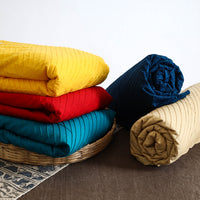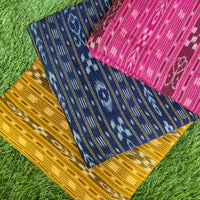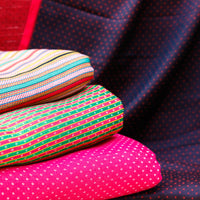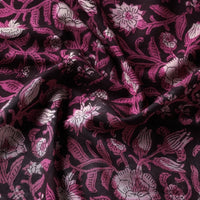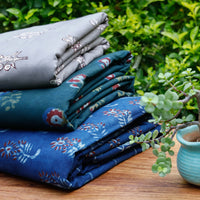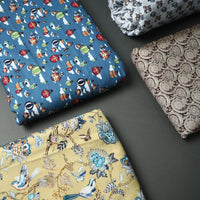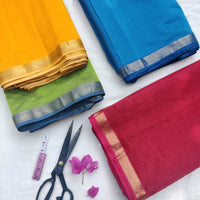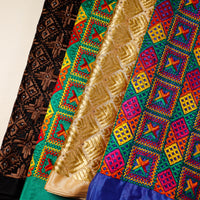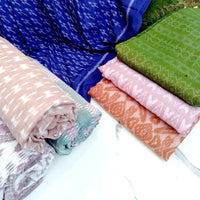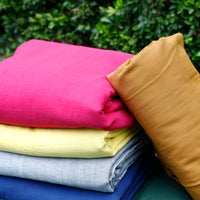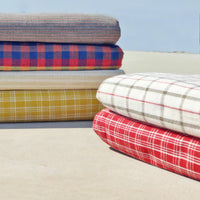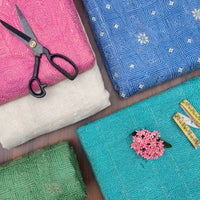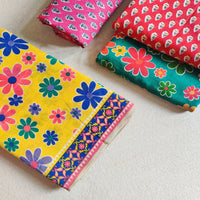Discover the Rich Legacy of Bagru Block Print Cotton Fabrics
Introduction: The Timeless Craft of Bagru Printing
Nestled in the heart of Rajasthan, the small town of Bagru is a living testament to India’s rich cultural heritage. Known globally for its distinctive block printing, Bagru has been a hub of traditional textile craftsmanship for over 400 years. The Bagru block print cotton fabrics, with their earthy tones and intricate patterns, are not just pieces of cloth but a canvas that tells the story of an entire community, a tradition passed down through generations, and a way of life deeply connected to nature and sustainability.
At iTokri, we are honored to be the custodians of this ancient craft, offering a platform where the rich legacy of Bagru printing can be celebrated and shared with the world. Our commitment to authenticity, cultural preservation, and sustainability drives us to work closely with the artisans of Bagru, ensuring that their stories, skills, and heritage continue to thrive in the modern world.
The Historical Significance of Bagru Printing
Bagru block printing is one of the oldest techniques in the Indian subcontinent, dating back to the 17th century. The craft has its roots in the migration of the Chhipa community, traditionally known as cloth printers, to the town of Bagru. Here, they found the perfect environment for their craft—a combination of natural resources, including the alluvial soil from the nearby Sanjariya river, and an abundant supply of natural dyes derived from local flora.
The Chhipas brought with them the knowledge and skills of block printing, which they adapted to the local environment. Over time, Bagru printing evolved into a distinctive style characterized by the use of natural dyes, hand-carved wooden blocks, and traditional motifs inspired by nature. The technique quickly became a symbol of the region’s identity, with the fabrics being used in everything from clothing to home décor.
The Region and Its People: The Heartbeat of Bagru
The town of Bagru is more than just a geographic location; it is the beating heart of the Bagru printing tradition. The town’s close-knit community is deeply intertwined with the craft, with almost every family in Bagru involved in some aspect of the printing process. The Chhipa community, which has been practicing this craft for centuries, is central to this cultural heritage.
The people of Bagru are known for their resilience and commitment to preserving their traditions. Despite the challenges posed by modern industrialization and the rise of mass-produced textiles, the artisans of Bagru have remained steadfast in their dedication to the craft. This commitment is not just about preserving a way of life but also about maintaining a connection to their ancestors, their land, and their identity.
The Process: A Symphony of Skill and Tradition
The process of creating Bagru block print cotton fabrics is a labor-intensive one, requiring a high degree of skill, patience, and artistry. It begins with the preparation of the fabric, usually cotton, which is washed and soaked in a mixture of water and turmeric to remove any impurities. This process, known as 'harda,' also helps to fix the natural dyes that will be applied later.
Next comes the block printing itself, where the artisans use hand-carved wooden blocks to stamp the designs onto the fabric. Each block is carved with intricate patterns, often depicting traditional motifs such as flowers, birds, and geometric shapes. The artisans dip the blocks into natural dyes and press them onto the fabric with precision, ensuring that each print is perfect.
One of the most distinctive aspects of Bagru printing is the use of natural dyes. These dyes are made from a variety of natural sources, including indigo for blues, madder root for reds, and pomegranate for yellows. The use of these dyes not only ensures that the fabrics are eco-friendly but also gives them a unique, earthy aesthetic that is instantly recognizable.
After the printing is complete, the fabric is left to dry in the sun. It is then washed again to remove any excess dye and to soften the fabric. The final product is a beautiful piece of cotton fabric that is not only a work of art but also a testament to the skill and dedication of the artisans who created it.
Human Interest Stories: The Artisans Behind the Craft
The story of Bagru printing is also the story of the artisans who have dedicated their lives to this craft. Take, for example, the story of Ramu Chhipa, a master craftsman who has been practicing Bagru printing for over 50 years. Ramu learned the craft from his father, who in turn learned it from his father. For Ramu, Bagru printing is not just a livelihood but a way of life. He speaks of the craft with a deep sense of pride and responsibility, knowing that he is part of a tradition that has been passed down through generations.
Ramu’s story is just one of many in Bagru. Each artisan has their own story to tell, their own connection to the craft, and their own way of contributing to the rich tapestry of Bagru printing. These stories are a reminder that Bagru printing is not just about creating beautiful fabrics; it is about preserving a way of life, a culture, and a community.
The Role of iTokri: Preserving and Promoting Bagru Printing
At iTokri, we understand the importance of preserving traditional crafts like Bagru printing. We are committed to supporting the artisans of Bagru by providing them with a platform to showcase their work to a global audience. By working directly with the artisans, we ensure that they receive fair compensation for their work and that their craft is preserved for future generations.
Our approach to e-commerce is unique in that it goes beyond mere transactions. We believe in creating a community around the crafts we promote, one that values authenticity, sustainability, and cultural preservation. Each product we offer is accompanied by a story—about the artisan who made it, the community it came from, and the tradition it represents.
In addition to supporting the artisans, we are also committed to sustainability. We use recycled materials in our packaging and promote eco-friendly crafts that minimize environmental impact. Our goal is to offer products that are not only beautiful and unique but also align with the values of our customers—values that include a respect for the environment, a desire for authenticity, and a commitment to supporting local communities.
Why Choose Bagru Cotton Fabrics?
Bagru cotton fabrics are more than just textiles; they are a piece of India’s cultural heritage. Each fabric is a unique work of art, created with care and precision by artisans who have been practicing their craft for generations. The natural dyes and hand-block printing techniques used in Bagru printing give these fabrics a distinctive look and feel that cannot be replicated by machine-made products.
When you choose Bagru cotton fabrics, you are not just purchasing a product; you are supporting a tradition, a community, and a way of life. You are choosing authenticity over mass production, sustainability over environmental degradation, and quality over quantity.
At iTokri, we are proud to offer a wide selection of Bagru cotton fabrics, each one a testament to the skill and creativity of the artisans of Bagru. Whether you are looking for fabric for clothing, home décor, or crafts, our collection has something to suit every taste and style.
Call-to-Action: Join the iTokri Movement
By choosing to shop at iTokri, you are not just buying a product; you are becoming part of a movement. A movement that values beauty, craftsmanship, and sustainability. A movement that supports artisans and preserves traditional crafts. A movement that celebrates India’s rich cultural heritage and shares it with the world.
We invite you to explore our collection of Bagru block print cotton fabrics and discover the beauty of this timeless craft. Each purchase you make helps to support the artisans of Bagru, ensuring that their craft continues to thrive in the modern world.
Experience the warmth of Indian hospitality and the luxury of genuine handcrafted products at iTokri. Shop with us today and be part of a movement that values beauty, craftsmanship, and a brighter future for artisans across India.
बगरू ब्लॉक प्रिंटिंग: एक परंपरा, एक धरोहर, और एक जीवनशैली का संरक्षण
राजस्थान के छोटे से शहर बगरू में 400 से भी अधिक वर्षों से पारंपरिक कपड़ा शिल्प का एक अद्वितीय इतिहास रहा है। बगरू ब्लॉक प्रिंटिंग, जो प्राकृतिक रंगों और हाथ से बने लकड़ी के ब्लॉक्स का उपयोग करके कपड़े पर जटिल डिज़ाइन बनाने की एक प्राचीन कला है, न केवल कपड़े पर छपाई की एक तकनीक है, बल्कि यह एक पूरी समुदाय की कहानी बताती है। यह शिल्प, पीढ़ियों से चली आ रही परंपरा और प्रकृति व स्थिरता से गहरे जुड़े जीवन का प्रतीक है।
iTokri इस प्राचीन शिल्प का संरक्षक होने पर गर्व महसूस करता है और बगरू के कारीगरों के साथ मिलकर इस समृद्ध धरोहर को संरक्षित और विश्वभर में साझा करने का प्रयास करता है। बगरू ब्लॉक प्रिंटिंग की प्रक्रिया में कपड़े की तैयारी, प्राकृतिक रंगों का उपयोग, और हाथ से बने ब्लॉक्स से छपाई शामिल है। यह प्रक्रिया काफी श्रमसाध्य होती है और इसमें उच्च कौशल और धैर्य की आवश्यकता होती है।
बगरू प्रिंटिंग का एक महत्वपूर्ण पहलू इसका पर्यावरण के प्रति संवेदनशील होना है। प्राकृतिक रंगों का उपयोग, जो स्थानीय वनस्पतियों से प्राप्त होते हैं, इसे पर्यावरण के अनुकूल बनाता है। बगरू के कारीगर, जो सदियों से इस कला को संजोए हुए हैं, अपनी मेहनत और कला के प्रति समर्पण के माध्यम से इस परंपरा को जीवित रखे हुए हैं।
iTokri का उद्देश्य न केवल इन कारीगरों का समर्थन करना है, बल्कि वैश्विक स्तर पर इस कला को बढ़ावा देना और इसे सजीव रखना है। बगरू कॉटन फैब्रिक का उपयोग वस्त्र, होम डेकोर और अन्य शिल्प में किया जा सकता है, जो न केवल खूबसूरत होते हैं बल्कि एक समृद्ध सांस्कृतिक धरोहर के हिस्से भी होते हैं।
इस प्रकार, जब आप iTokri से बगरू कॉटन फैब्रिक खरीदते हैं, तो आप एक परंपरा, एक समुदाय, और एक जीवनशैली का समर्थन करते हैं जो स्थिरता और प्रामाणिकता को महत्व देती है।

















